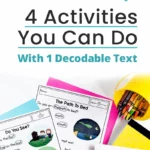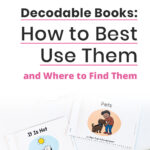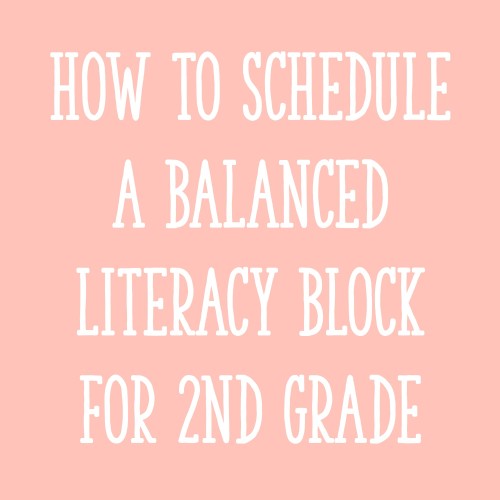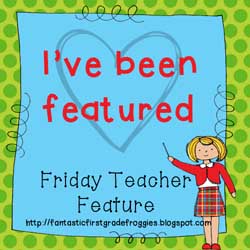Some teachers solely use leveled texts, some only use decodable texts, and some use a combination of both. And recently, many teachers have been making a shift from leveled to decodable texts. If this is you, you might find yourself wondering, “How do you get a reading level from a decodable text?”
Before we dig into that question, a little bit of background:
A reading level is a letter or number assigned to a book that is intended to indicate the difficulty level of the text. There are many different leveling systems – DRA, Fountas & Pinnell, Lexile, etc. To make matters even more complicated, each leveling system has different qualifications for leveling books.
For more information about the differences between leveled books and decodable readers, check out these two blogs I’ve written previously:
- Are Leveled Books Bad?
- Decodable Books: What Are They, and How Should I Use Them With My K-2 Students?
Now, back to the question of how you might get a reading level from a decodable text. In this post, I have a video (and transcript, if you prefer to read) that provides directions on how (and if!) you can do this.
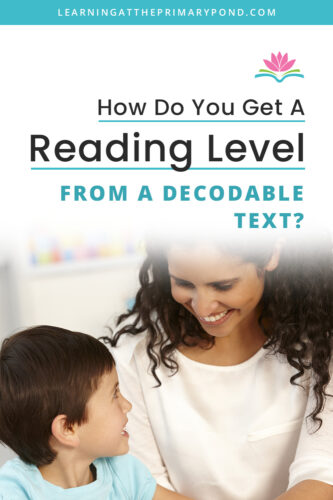
Transcript if you prefer to read:
“Hey, I’m Alison from Learning At The Primary Pond. I’m a literacy specialist, and in this video I’m going to share how to get, and if you can get, a reading level for a student from decodable texts. If you haven’t subscribed to my channel (https://www.youtube.com/@learningattheprimarypond), make sure to do that now, and then also hit the little bell so that you’re notified every time I post a brand new video about teaching literacy in K-2.
As far as different types of texts go, you may have heard that some texts are considered leveled and some texts are considered decodable. We will talk about the differences between the two types of texts, but I am curious, a lot of teachers at the time that I’m recording this are kind of making a shift from using mostly leveled texts to maybe mostly decodable texts, or more decodable texts. So I’m curious where you are at. Let me know in the comments, are you using mostly decodable, mostly levels, a combination? I know it probably also depends on the grade level of the students that you are working with, but let’s make sure we talk about what decodable and leveled are.
A reading level in general is some type of letter or number assigned to a book that is intended to describe the difficulty level of the text. There are many different leveling systems. There’s DRA, Fountas and Pinnell, Lexile. And then to make things more complicated, each leveling system has different qualifications for leveling the books. We’re not going to get into all of that today, but leveling can be complex. And then decodable texts, if you’re not familiar with those, are called decodable because they are designed to where the majority of the words, if not all of the words, should be able to be decoded by students based upon the phonics patterns and phonic skills they’ve learned.
If you have a decodable text that’s focused on short vowels, it’s not going to include vowel teams and long vowels because the focus is short vowels. So it’s really restricted to the patterns, and the high frequency words that the kids have been taught. So generally speaking, that’s what leveled versus decodable means.
For so many years, teachers and schools have used a reading level and said, ‘Oh, a student is at this level.’ And maybe they’ve even shared with the parents, ‘Oh, your child is at this level, and that means that they’re on grade level’, or ‘they’re a little behind,’ or ‘they’re a little ahead.’ It’s almost like it has become a language, it has become a comfort thing.
However, I think that if you’ve made the transition to using mostly decodable books, I would encourage you to kind of shift your mindset, and not be as concerned about giving parents, or knowing, what reading level a child is at. I feel like there’s some other information that will probably be even more valuable to you to know and use. So that being said, let’s get into it. If you don’t have a reading level, how do we know what students are doing? Well, my free phonics diagnostic (https://www.teacherspayteachers.com/Product/Free-Phonics-Diagnostic-Assessment-7565061) can help with that.
If you’re using decodable texts, it’s all about a student’s level of acquisition with different phonic skills, and level of mastery. This free phonics diagnostic (https://www.teacherspayteachers.com/Product/Free-Phonics-Diagnostic-Assessment-7565061) has them reading words and spelling words with specific phonics patterns. I don’t know how large it will be on your end, but it will kind of tell you, based upon what they know and what they don’t know yet, specific skills to work on. So, this is a really helpful tool.
You are going to have, ideally, a phonic scope and sequence, or your school provides that, or you have it from a program. Based upon their performance, whether it’s on this or some other type of phonics assessment, I will include a link (https://www.teacherspayteachers.com/Product/Free-Phonics-Diagnostic-Assessment-7565061) for this free one, by the way, along with this video. You can look at this scope and sequence and say, ‘Okay, at this time in the year, students are supposed to be here. While this student is here, they’re on grade level. This student is here, they’re working above grade level. This student is here, they’re working below grade level.’ So, that can kind of help you make sense of it, even if it’s not a number or a letter, like you might be used to.
Some other tips along with assessment: You’ll have decodable readers that are really focused on SH, and there’s a lot of SH words in there, for example. But, I also feel like it’s helpful to have decodable readers that cover multiple skills that you’ve been teaching and not just only focus on one. So this is an example from my 1st grade decodable safari set, Secretary Bird. (https://www.teacherspayteachers.com/Product/Decodable-Safari-Texts-Nonfiction-Decodable-Passages-for-1st-Grade-7481231)
And this is made up of, with the exception of any pre-teaching words that the teacher teaches ahead of time, blends and glued sounds. So if you listen to a child read this text, you will have a good sense of… are they able to take that phonics knowledge and apply it to the text? Are they able to read the blends? Are they able to read the glued sounds? It doesn’t necessarily focus on just one thing, but it will tell you, ‘Okay, how was our level of mastery with these skills in general?’
Here’s another example, this is a 2nd grade example from my 2nd grade winter decodables. (https://www.teacherspayteachers.com/Product/Winter-Decodable-Texts-for-Second-Grade-Passages-on-Winter-and-Winter-Holidays-8810632) The focus in this one is on closed syllable exceptions like in mild and inflectional endings. So not only are you able to see, ‘Okay, how does this group of students, or how does this child do with this one skill, but how are they doing with all of these phonic skills?’ So, decodable texts that cover more than just one skill can be really helpful with that.
Along with that, when you’re having them read a decodable text, whether it is something that’s focused on multiple skills or it’s just one skill, a running record can be really helpful. Running records lately have been getting kind of a bad reputation, but if you do them the way I do them, you’re literally just determining, ‘Okay, how is a child doing with the words in the text?’ You’re seeing, did they get it right? Did they get it wrong? Running records give you so much valuable data to where you can see if the child is missing, for example, a bunch of digraphs, and you see that from the running record, then that tells you, ‘Hey, we have not mastered digraphs yet.’
Running records can be really helpful, even if they’re not necessarily giving you a specific reading level. To sum it up, I think if you’re using mostly decodable texts, it’s all about somewhat of a mindset shift and figuring out, ‘Okay, what’s the scope and sequence? Where is the student on this scope and sequence? Is that above where they should be right now or is it below?’
Knowing what phonics skills specifically they need to work on is really helpful, and that will give you more information. It will even give parents more information if you’re doing conferences to tell them, ‘Hey, this is what we’re working on. We still have all of this to do’ or, ‘Hey, we’re working ahead.’ You might have to show them a phonics scope and sequence, a list of skills as well. But it can still be really valuable information to them even if it’s not like a reading level. And you’ll, of course, have to explain if they’re accustomed to seeing reading levels, how this way of thinking is a little bit different.I showed a lot of different resources. I showed the free phonics diagnostic (https://www.teacherspayteachers.com/Product/Free-Phonics-Diagnostic-Assessment-7565061, I showed some decodable texts (https://www.teacherspayteachers.com/Product/Decodable-Safari-Texts-Nonfiction-Decodable-Passages-for-1st-Grade-7481231 and https://www.teacherspayteachers.com/Product/Winter-Decodable-Texts-for-Second-Grade-Passages-on-Winter-and-Winter-Holidays-8810632). If you’re looking for anything else, feel free to let me know. Thanks so much for watching, don’t forget to hit the subscribe (https://www.youtube.com/@learningattheprimarypond) button and the like button, and I’ll see you in the next video.”
Conclusion
I hope this information is helpful! If you need decodable texts for your K-2 students, check out some of the options I have to offer! (All of these include the actual texts, accompanied by lesson plans, writing prompts, and additional activities for every passage!)
- Decodable Readers – available in a K-2 bundle as well as for Kindergarten, First Grade, and Second Grade individually
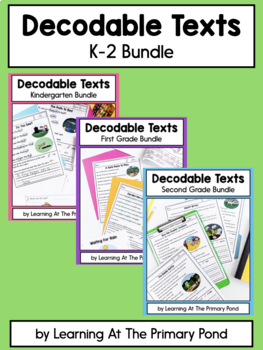
- Decodable Safari Texts – available in a K-2 bundle as well as for Kindergarten, First Grade, and Second Grade individually

- Seasonal/Holiday Decodable Texts – there are Winter, Spring, and Summer, and Fall sets are available! They come either in a bundle or individually for Kindergarten, first grade, or second grade.
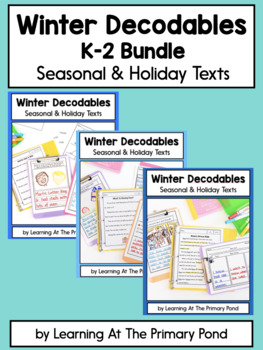

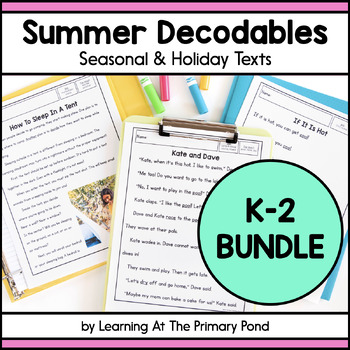
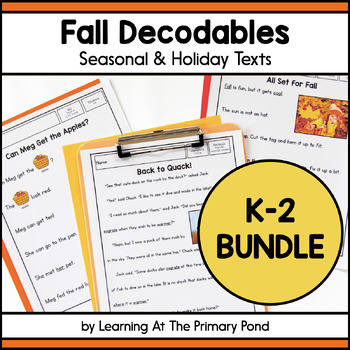
Happy teaching!

